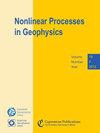理解分层流体过程研究模型中流体混合的新方法
IF 2.4
4区 地球科学
Q3 GEOSCIENCES, MULTIDISCIPLINARY
引用次数: 0
摘要
摘要虽然在过程研究数值模式中量化近岸混合的成熟的基于能量的方法经常被用来提供混合发生的时间和混合程度的信息,但描述这种混合是如何发生的以及在哪里发生的仍然是一个挑战。此外,基于密度场排序的方法,在模型分辨率不足时,以及在存在水深测量时,参考密度的定义不确定时,也很难奏效。这里提出了另一种理解混合的方法。用户选择变量的配对直方图(我们简称 USP(用户控制散点图))用于识别混合流体,然后用于显示物理空间中正在发生混合的流体区域。本文介绍了展示这种方法的两个案例研究:浅滩内孤波和受状态方程非线性影响的冷水剪切不稳定性。对于第一个案例,USP 方法确定了与不同内孤波破碎类型相关的混合过程的差异,包括混合流体的水平范围和平流的差异。对于第二种情况,该方法用于确定密度和被动示踪剂如何在非对称冷水开尔文-赫尔姆霍兹不稳定性核心内混合。本文章由计算机程序翻译,如有差异,请以英文原文为准。
A new approach to understanding fluid mixing in process-study models of stratified fluids
Abstract. While well-established energy-based methods of quantifying diapycnal mixing in process-study numerical models are often used to provide information about when mixing occurs, and how much mixing has occurred, describing how and where this mixing has taken place remains a challenge. Moreover, methods based on sorting the density field struggle when the model is under-resolved and when there is uncertainty as to the definition of the reference density when bathymetry is present. Here, an alternative method of understanding mixing is proposed. Paired histograms of user-selected variables (which we abbreviate USPs (user-controlled scatter plots)) are employed to identify mixing fluid and are then used to display regions of fluid in physical space that are undergoing mixing. This paper presents two case studies showcasing this method: shoaling internal solitary waves and a shear instability in cold water influenced by the nonlinearity of the equation of state. For the first case, the USP method identifies differences in the mixing processes associated with different internal solitary wave breaking types, including differences in the horizontal extent and advection of mixed fluid. For the second case, the method is used to identify how density and passive tracers are mixed within the core of the asymmetric cold-water Kelvin–Helmholtz instability.
求助全文
通过发布文献求助,成功后即可免费获取论文全文。
去求助
来源期刊

Nonlinear Processes in Geophysics
地学-地球化学与地球物理
CiteScore
4.00
自引率
0.00%
发文量
21
审稿时长
6-12 weeks
期刊介绍:
Nonlinear Processes in Geophysics (NPG) is an international, inter-/trans-disciplinary, non-profit journal devoted to breaking the deadlocks often faced by standard approaches in Earth and space sciences. It therefore solicits disruptive and innovative concepts and methodologies, as well as original applications of these to address the ubiquitous complexity in geoscience systems, and in interacting social and biological systems. Such systems are nonlinear, with responses strongly non-proportional to perturbations, and show an associated extreme variability across scales.
 求助内容:
求助内容: 应助结果提醒方式:
应助结果提醒方式:


